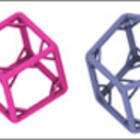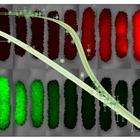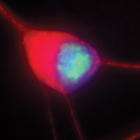Small-RNA Pathway Defends Genome Against the Enemy Within
March 17, 2024 1:50 pm | News | CommentsReproductive cells, such as an egg and sperm, join to form stem cells that can mature into any tissue type. But how do reproductive cells arise? We humans are born with all of the reproductive cells that we will ever produce. But in plants things are very different. They first generate mature, adult cells and only later “reprogram” some of them to produce eggs and sperm.
Novel Approach Finds New Gene Linked to Heart Attack Risk
March 17, 2024 11:56 am | News | CommentsScientists have discovered a previously unrecognized gene variation that makes humans have healthier blood lipid levels and reduced risk of heart attacks- a finding that opens the door to new testing or treatment of high cholesterol and other lipid disorders.
Gene Family Proven to Suppress Prostate Cancer
March 14, 2024 1:45 pm | News | CommentsCornell researchers report they have discovered direct genetic evidence that a family of genes, called MicroRNA-34 (miR-34), are bona fide tumor suppressors. Previous research has shown that another gene, called p53, acts to positively regulate miR-34. Mutations of p53 have been implicated in half of all cancers. miR-34 is also frequently silenced by mechanisms other than p53 in many cancers, including those with p53 mutations.
Roomy Cages Built From DNA
March 14, 2024 1:38 pm | Videos | CommentsScientists at the Harvard's Wyss Institute have built a set of self-assembling DNA cages one-tenth as wide as a bacterium. The structures are some of the largest and most complex structures ever constructed solely from DNA. The scientists visualized them using a DNA-based super-resolution microscopy method — and obtained the first sharp 3D optical images of intact synthetic DNA nanostructures in solution.
An Equation to Describe the Competition Between Genes
March 14, 2024 1:28 pm | News | CommentsIn biology, scientists typically conduct experiments first, and then develop mathematical or computer models afterward to show how the collected data fit with theory. In his work, Rob Phillips flips that practice on its head. The Caltech biophysicist tackles questions in cellular biology as a physicist would—by first formulating a model that can make predictions and then testing those predictions.
Breast Cancer Gene Protects Against Obesity, Diabetes
March 12, 2024 2:24 pm | News | CommentsThe gene known to be associated with breast cancer susceptibility, BRCA 1, plays a critical role in the normal metabolic function of skeletal muscle, according to a new study. The team is the first to identify that the BRCA1 protein is expressed in the skeletal muscle of both mice and humans, and that it plays a key role in fat storage, insulin response, and mitochondrial function in skeletal muscle cells.
Scientists Confirm Link Between Missing DNA and Birth Defects
March 12, 2024 1:44 pm | News | CommentsIn 2010, scientists reported that a woman and her daughter showed a puzzling array of disabilities, including epilepsy and cleft palate. The research team noted that the mother and daughter were missing a large chunk of DNA on their X chromosome. Researchers were unable to definitively show that the problems were tied to that genetic deletion. Now a team has confirmed that those patients’ ailments resulted from the genetic anomaly.
US Gene Mapping Study Shows Promise, Challenges
March 11, 2024 6:17 pm | by Lindsey Tanner - AP Medical Writer - Associated Press | News | CommentsThese days, it's faster and cheaper than ever to decipher a person's entire DNA. But a small U.S. study suggests that looking for disease risks that way may not be ready for the masses. For one thing, the research found that gene variants most likely linked with significant disease were the least likely to be accurately identified. And analyzing the mass of data from the DNA scan is a daunting task, researchers said.
A Tale of Two Data Sets: New DNA Analysis Strategy Helps Researchers Cut through the Dirt
March 11, 2024 1:00 pm | Videos | CommentsFor soil microbiology, it is the best of times. While no one has undertaken an accurate census, a spoonful of soil holds hundreds of billions of microbial cells, encompassing thousands of species. Researchers have now published the largest soil DNA sequencing effort to date.
Breaking News: New Gene for Bipolar Discovered
March 11, 2024 12:00 pm | News | CommentsAn international group of researchers discovered two new gene regions which are connected with bipolar disorder. They were also able to confirm three additional suspect genes.
Alzheimer’s Research Team Employs Stem Cells to Understand Disease Processes and Study New Treatments
March 10, 2024 12:53 pm | News | CommentsA team of Alzheimer’s disease (AD) researchers at Brigham and Women’s Hospital has been able to study the underlying causes of AD and develop assays to test newer approaches to treatment by using stem cells derived from related family members with a genetic predisposition to AD.
Cells Appearing Normal May Actually be Harbingers of Lung Cancer
March 7, 2024 1:42 pm | News | CommentsSeemingly healthy cells may hide clues that lung cancer will later develop, according to a study led by researchers at The University of Texas MD Anderson Cancer Center. Examination of gene expression in patients with non-small cell lung cancer showed the area adjacent to tumors is rich with cancer markers. In addition, researchers discovered the previously unknown role of a cancer-promoting gene in the airways of smokers with lung cancer.
The Benefits of Personalized Medicine: What Is It?
March 6, 2024 2:54 pm | Videos | CommentsPersonalized medicine is a term you hear a lot in life science and drug industry discussions. Follow along as Rob Fee, Editor-in-Chief of Bioscience Technology, introduces a six-part video series from Bioscience Technology and Drug Discovery & Development that will explain what personalized medicine is, how it works, and the potential of this concept.
3-D Changes in DNA May Lead to a Genetic Form of Lou Gehrig’s Disease
March 6, 2024 2:26 pm | News | CommentsNew findings reveal how a mutation, a change in the genetic code that causes neurodegeneration, alters the shape of DNA, making cells more vulnerable to stress and more likely to die. The particular mutation, in the C9orf72 gene, is the most common cause for amyotrophic lateral sclerosis (ALS, also known as Lou Gehrig’s disease), and frontotemporal degeneration (FTD), the second most common type of dementia in people under 65.
Gene Therapy Seems Safe, May Help Control HIV
March 5, 2024 5:18 pm | by Marilynn Marchione - AP Chief Medical Writer - Associated Press | News | CommentsScientists have modified genes in the blood cells of HIV patients to help them resist the AIDS virus, and say the treatment seems safe and promising. The results give hope that this approach might one day free at least some people from needing medicines to keep HIV under control, a form of cure.
Gene Identified for Butterfly Wing Marking Mimicry
March 5, 2024 1:19 pm | by Malcolm Ritter - AP Science Writer - Associated Press | News | CommentsTo fool predators, some butterflies create wing color patterns that make them resemble their unpalatable cousins. Only recently have scientists been unraveling how they do that, and now researchers have identified the gene that does the trick for an Asian swallowtail.
Tracking Genes on the Path to Genetic Treatment
March 3, 2024 11:13 am | News | CommentsAlthough scientists have decoded the human genome, they still have great difficulty determining the specific genes that are activated to make a kidney cell as opposed to a liver or heart cell. In theory, an easy way to link genes to cells would be to isolate a cell and test it. However, solid human tissue is so closely packed that even the finest surgical techniques cannot separate types of cells efficiently enough for analysis.
Study Pinpoints Protective Mutations for Type 2 Diabetes
March 3, 2024 11:03 am | News | CommentsA team of researchers identified mutations in a gene that can reduce the risk of developing type 2 diabetes, even in people who have risk factors such as obesity and old age. The results focus the search for developing novel therapeutic strategies for type 2 diabetes; if a drug can be developed that mimics the protective effect of these mutations, it could open up new ways of preventing this devastating disease.
A Bird's Eye View of Cellular RNAs
February 28, 2024 11:57 am | Videos | CommentsIn biology, as in real estate, location matters. Working copies of active genes—called messenger RNAs or mRNAs—are positioned strategically throughout living tissues, and their location often helps regulate how cells and tissues grow and develop. But to analyze many mRNAs simultaneously, scientists have had to grind cells to a pulp, which left them no good way to pinpoint where those mRNAs sat within the cell.
One Gene Influences Recovery from Traumatic Brain Injury
February 27, 2024 2:01 pm | News | CommentsResearchers report that one tiny variation in the sequence of a gene may cause some people to be more impaired by traumatic brain injury (TBI) than others with comparable wounds. The study measured general intelligence in a group of 156 Vietnam War veterans who suffered penetrating head injuries during the war. All of the study subjects had damage to the prefrontal cortex.
DNA Blood Tests Show Prenatal Screening Promise
February 26, 2024 5:17 pm | by Marilynn Marchione - AP Chief Medical Writer - Associated Press | News | CommentsA DNA test of a pregnant woman's blood is more accurate than current methods of screening for Down syndrome and other common disorders, new research finds. If other studies bear this out, it could transform prenatal care.
'How Well Did You Sequence that Genome?' NIST, Consortium Partners Have Answer
February 26, 2024 1:43 pm | News | CommentsIn December 2013, the U.S. Food and Drug Administration approved the first high-throughput DNA sequencer. Helping get the new device approved was another first: the initial use of a reference set of standard genotypes, or "coded blueprints" of a person's genetic traits.
Species Conservation Poised to Benefit from DNA Advances
February 25, 2024 11:58 am | News | CommentsA biologist at the University of York is part of an international team which has shown that advanced DNA sequencing technologies can be used to accurately measure the levels of inbreeding in wild animal populations. New research used high throughput sequencing, generating more than 10,000 genetic markers, to assess inbreeding in a captive mouse population as well as in wild harbor seals.
New Technology Detects Cellular Memory
February 24, 2024 2:18 pm | News | CommentsCells in our body are constantly dividing to maintain our body functions. At each division, our DNA code and a whole machinery of supporting components has to be faithfully duplicated to maintain the cell’s memory of its own identity. Researchers at BRIC, University of Copenhagen, have developed a new technology that has revealed the dynamic events of this duplication process and the secrets of cellular memory.
FDA Weighs Risks of 3-person Embryo Fertilization
February 24, 2024 11:08 am | by Matthew Perrone - AP Health Writer - Associated Press | News | CommentsFederal health regulators will consider this week whether to green light a provocative new fertilization technique that could eventually create babies from the DNA of three people, with the goal of preventing mothers from passing on debilitating genetic diseases to their children.
- Page 1
- Next









